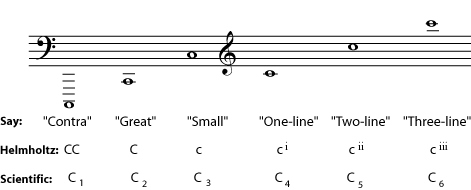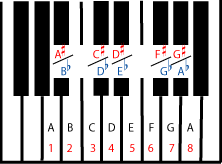| << Chapter < Page | Chapter >> Page > |
But there are also two formal systems for naming the notes in a particular octave. Many musicians use Helmholtz notation. Others prefer scientific pitch notation , which simply labels the octaves with numbers, starting with C1 for the lowest C on a full-sized keyboard. Figure 3 shows the names of the octaves most commonly used in music.

The octave below contra can be labelled CCC or Co; higher octaves can be labelled with higher numbers or more lines. Octaves are named from one C to the next higher C. For example, all the notes between "great C" and "small C" are "great". One-line c is also often called "middle C". No other notes are called "middle", only the C.

The word "octave" comes from a Latin root meaning "eight". It seems an odd name for a frequency that is two times, not eight times, higher. The octave was named by musicians who were more interested in how octaves are divided into scales, than in how their frequencies are related. Octaves aren't the only notes that sound good together. The people in different musical traditions have different ideas about what notes they think sound best together. In the Western musical tradition - which includes most familiar music from Europe and the Americas - the octave is divided up into twelve equally spaced notes. If you play all twelve of these notes within one octave you are playing a chromatic scale . Other musical traditions - traditional Chinese music for example - have divided the octave differently and so they use different scales. (Please see Major Keys and Scales , Minor Keys and Scales , and Scales that aren’t Major or Minor for more about this.)
You may be thinking "OK, that's twelve notes; that still has nothing to do with the number eight", but out of those twelve notes, only seven are used in any particular major or minor scale. Add the first note of the next octave, so that you have that a "complete"-sounding scale ("do-re-mi-fa-so-la-ti" and then "do" again), and you have the eight notes of the octave . These are the diatonic scales, and they are the basis of most Western music.
Now take a look at the piano keyboard. Only seven letter names are used to name notes: A, B, C, D, E, F, and G. The eighth note would, of course, be the next A, beginning the next octave. To name the other notes, the notes on the black piano keys, you have to use a sharp or flat sign.

Whether it is a popular song, a classical symphony, or an old folk tune, most of the music that feels comfortable and familiar (to Western listeners) is based on either a major or minor scale. It is tonal music that mostly uses only seven of the notes within an octave: only one of the possible A's (A sharp, A natural, or A flat), one of the possible B's (B sharp, B natural, or B flat), and so on. The other notes in the chromatic scale are (usually) used sparingly to add interest or to (temporarily) change the key in the middle of the music. For more on the keys and scales that are the basis of tonal music, see Major Keys and Scales and Minor Keys and Scales .

Notification Switch
Would you like to follow the 'Introduction to music theory' conversation and receive update notifications?